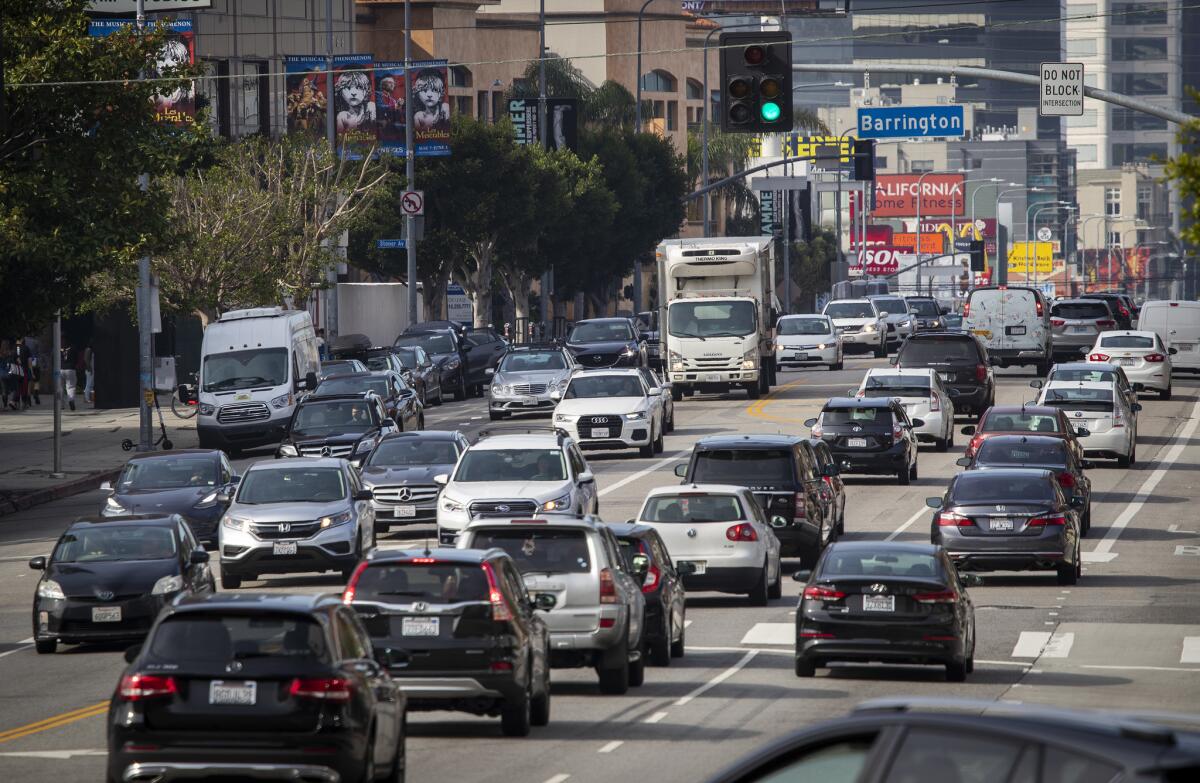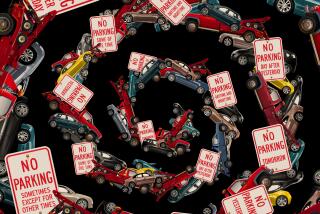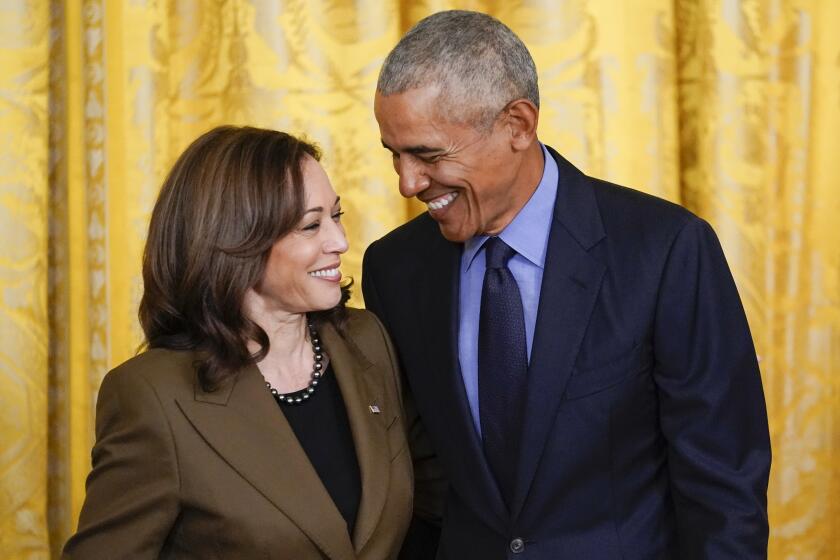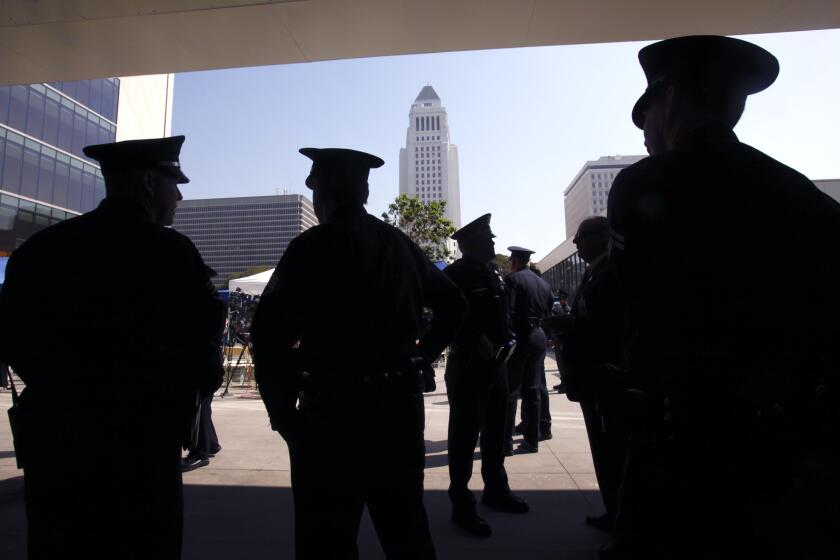Pay $4 to drive to the Westside? Congestion pricing could cut traffic gridlock, report says

Charging drivers a fee to reduce traffic jams has worked in London, Milan and Stockholm, and the idea is gaining ground in New York.
But in Southern California, elected officials have approached the question of congestion pricing with trepidation, saying that such a dramatic shift in a driving-dependent region would require detailed study of its impacts.
The region’s first such study, released Thursday by the Southern California Assn. of Governments, suggests that charging drivers to enter an area of West Los Angeles and Santa Monica just west of the 405 Freeway and north of the 10 Freeway could significantly smooth out rush-hour traffic jams and speed commute times.
A $4 fee to drive into the 4.3-square-mile area during weekday rush hour could almost immediately reduce traffic delays and miles driven there by more than 20%, the analysis found.
Such a drop in driving would correspond with a 9% increase in transit ridership, a 7% increase in biking and a 7% increase in walking inside the zone, indicating that the region doesn’t need sky-high tolls “to really effect the kind of behavior change that we’re looking for,” said Annie Nam, the SCAG manager who oversaw the study.
The report comes a month after the Metropolitan Transportation Authority agreed to study the concept of congestion pricing across Los Angeles County.
The SCAG study assumed tolls would be assessed through the Fastrak transponders already in use across California, including on the 110 and 10 freeway toll lanes. License plate readers could be installed to identify and bill drivers who do not have transponders.
Before such a fee could be assessed, officials would need to find an agency to plan and implement the pricing strategy, change state law to allow tolling on surface streets, and conduct extensive public outreach.
But the findings are not a purely academic exercise. Darin Chidsey, SCAG’s interim executive director, said it’s “very likely” that the first place Southern California could see a toll on surface streets would be on the traffic-choked Westside.
SCAG had initially considered studying tolling in downtown Los Angeles, Santa Monica, Hollywood, West Hollywood, Warner Center and Los Angeles International Airport, but focused on the Westside because the traffic is worst there, so congestion pricing could have the greatest effect, Chidsey said.
“This isn’t a proposal; it’s a model,” said Los Angeles City Councilman Mike Bonin, who represents part of the studied area. “As models go, this probably has as much chance of flying as a model airplane.”
To sell an ambitious idea like congestion pricing to the public, drivers would need to have access to high-quality alternatives to driving up and running before the fees were assessed, Bonin said. On the Westside, he said, those alternatives are “not in place yet.”
Toll zones would make sense sooner in downtown or around LAX once the train to the airport’s central terminal area is completed, Bonin said.
“If you are going to pick an area of the city to do this, history suggests that people on the Westside have the means and the resources and the time to object to stuff they don’t like,” Bonin said. “Absent a very different approach to this … I think it would be a very controversial idea.”
A lack of public support, or outright opposition, could be the plan’s fatal flaw, researchers wrote in the study. Polling found that support for a congestion tax peaked at 40%, Nam said.
Under the study’s parameters, the highest number of peak-hour commuters to the tolled zone would come from wealthy communities, including Brentwood, Bel Air and Westwood.
Researchers had considered a congestion fee of $6 to $8, Nam said, but they revised it downward to $4 after resistance from focus groups. The amount, she said, is “just enough of a nudge to see sizable benefits.”
Vehicles driving in and out multiple times during the peak traffic period would be charged only once. Leaving the area would be free.
The study assumed that residents would pay 40 cents — a 90% discount — and low-income commuters could qualify for half-price tolls. The fee for low-income commuters will likely be a friction point.
“I’m very, very wary of a model that gives a 90% discount to a CEO of a billion-dollar company and gives only a 50% discount to the gardener who drives to maintain that person’s estate,” Bonin said.
Tim Drain, 31, of Koreatown said he generally supports the idea of congestion pricing in Los Angeles but would like to see an exemption for workers who use their cars to transport the tools and supplies they need on job sites.
Drain works on home improvement projects for an interior design company, and ends up in the studied area about once a week, he said, with “too much stuff to take on transit.”
“I might be able to push it some days past 9 a.m.” to avoid the congestion charge, he said. “But probably about half the time, I’m still gonna be in that window, and I’d have to pay.”
The study found that some drivers would reduce the number of trips they took, researchers said, while others would shift their travel to other times. That would result in an increase in miles driven in the early afternoon and after evening rush hour. But overall, trips would be expected to fall by nearly 8%.
Allowing three-person carpools to enter the tolled zone for free would increase the rate of of carpooling by 51%, researchers found.
For those who continue to drive, time spent behind the wheel in the tolled area would drop by nearly one-fourth because there would be less congestion, the study found.
To be successful, the toll would need to be coupled with significant investments in easy, reliable alternatives to driving, researchers said. That could include protected bicycle lanes and express bus service for commuters from Torrance and Encino.
The fees would generate an annual average of $69 million in net revenue that could be spent on those projects, researchers said.
“It’s a horrible idea,” said Kathleen Black of Brentwood, who takes her children, ages 6 and 10, to Sawtelle several times a month to eat, shop, run errands and go to the doctor. Parents who run errands with children after they get out of school would be charged in the afternoon, she said.
“It’s a penalty for being a patron of an area that I’m very happy to patronize,” said Black, 45. “We love it there, but I just don’t think we would go anymore if we had to pay.”
In other cities that have tried congestion pricing, people typically oppose the system before they’ve seen it work, said Brian Taylor, director of UCLA’s Institute for Transportation Studies. But “when people see it in practice, they tend to go majority opposition to majority support.”
In 2003, officials imposed a toll to enter central London between 7 a.m. and 6 p.m. Over a decade, the change — fought by auto interest groups and business owners — reduced congestion by 10% and raised the equivalent of $3 billion.
Next month, London is adding a toll equivalent to about $16.50 on polluting vehicles that enter the area. The fee will be expanded to a broader swath of London in 2021.
For more transportation news, follow @laura_nelson on Twitter.
More to Read
Sign up for Essential California
The most important California stories and recommendations in your inbox every morning.
You may occasionally receive promotional content from the Los Angeles Times.











